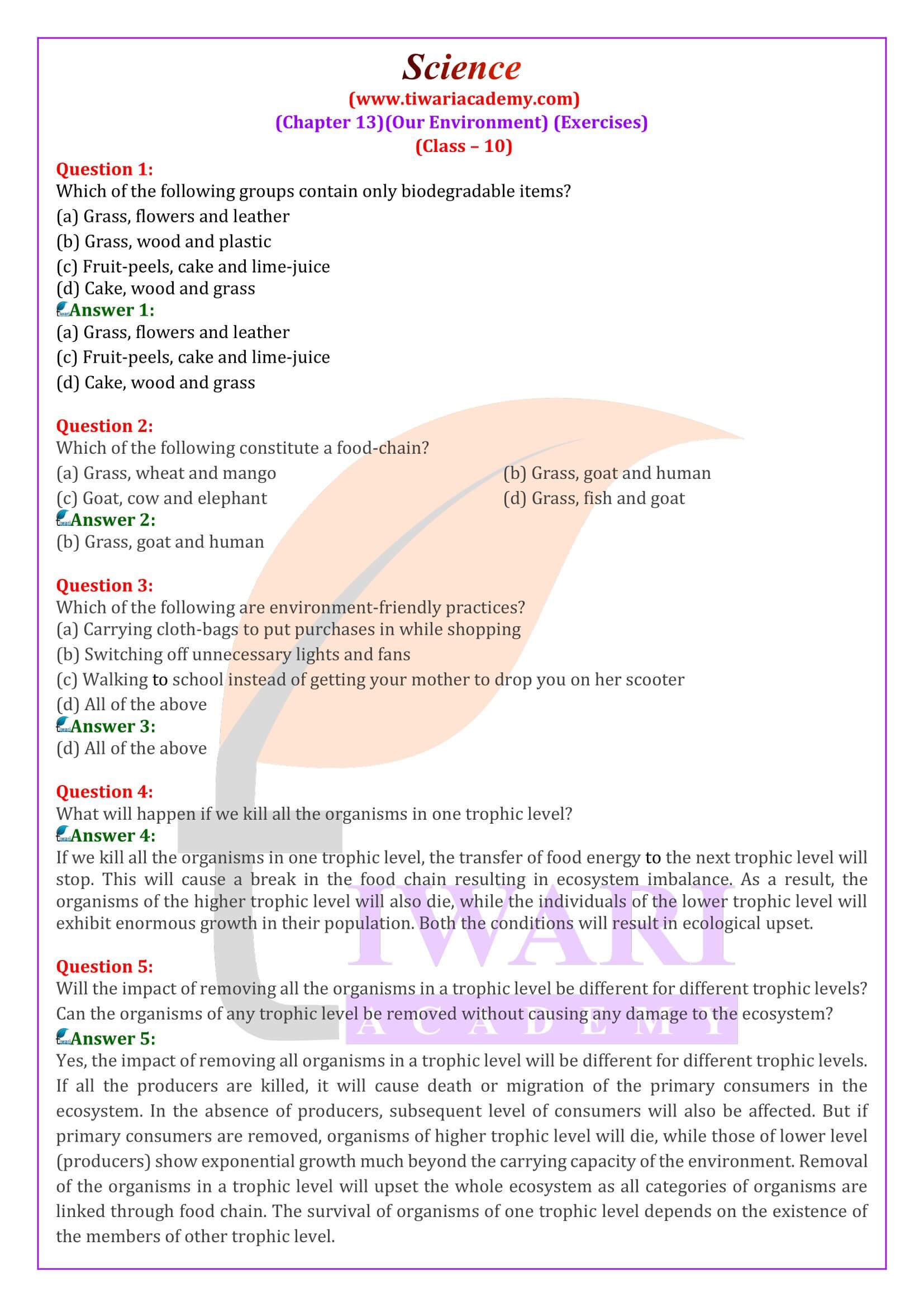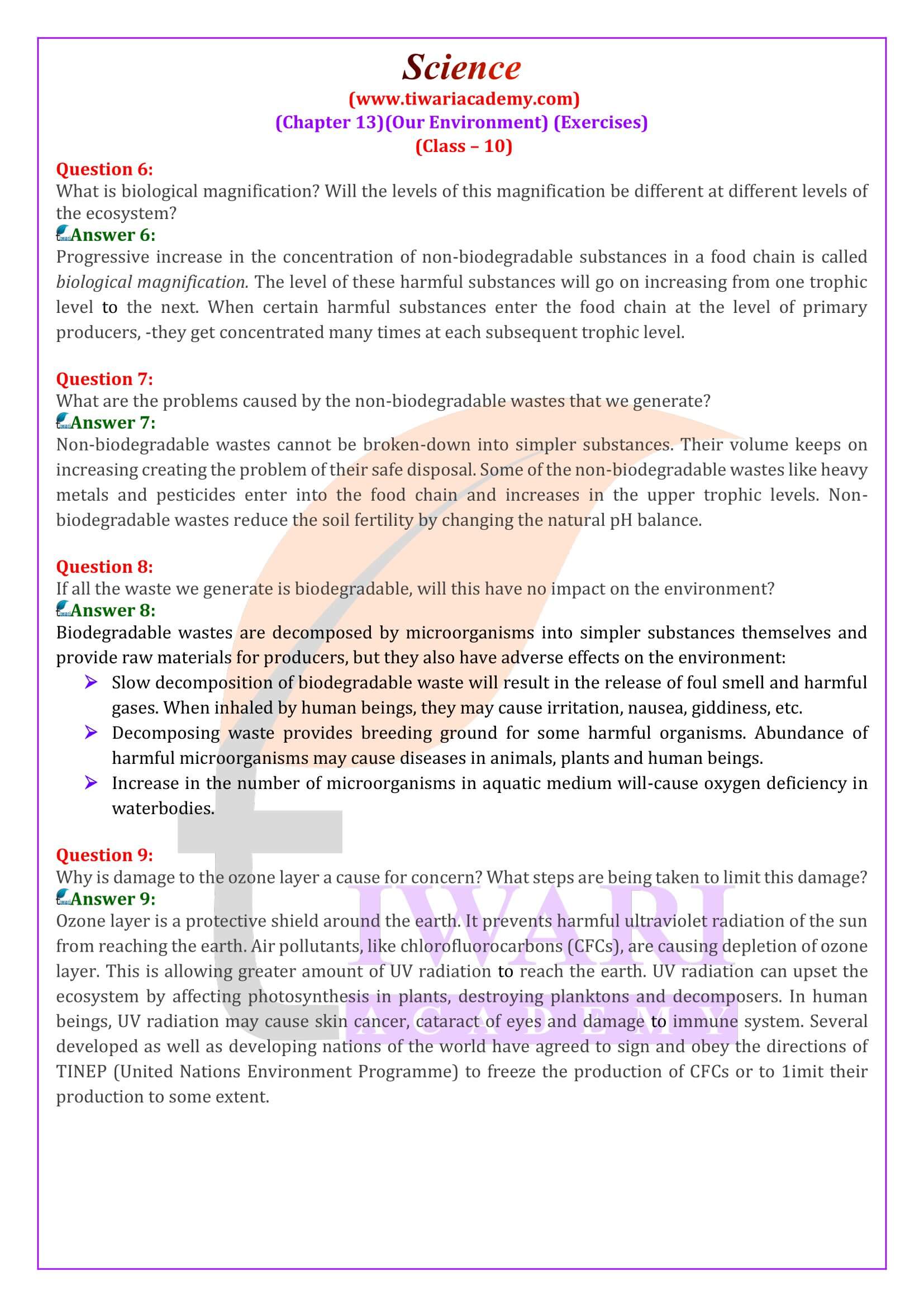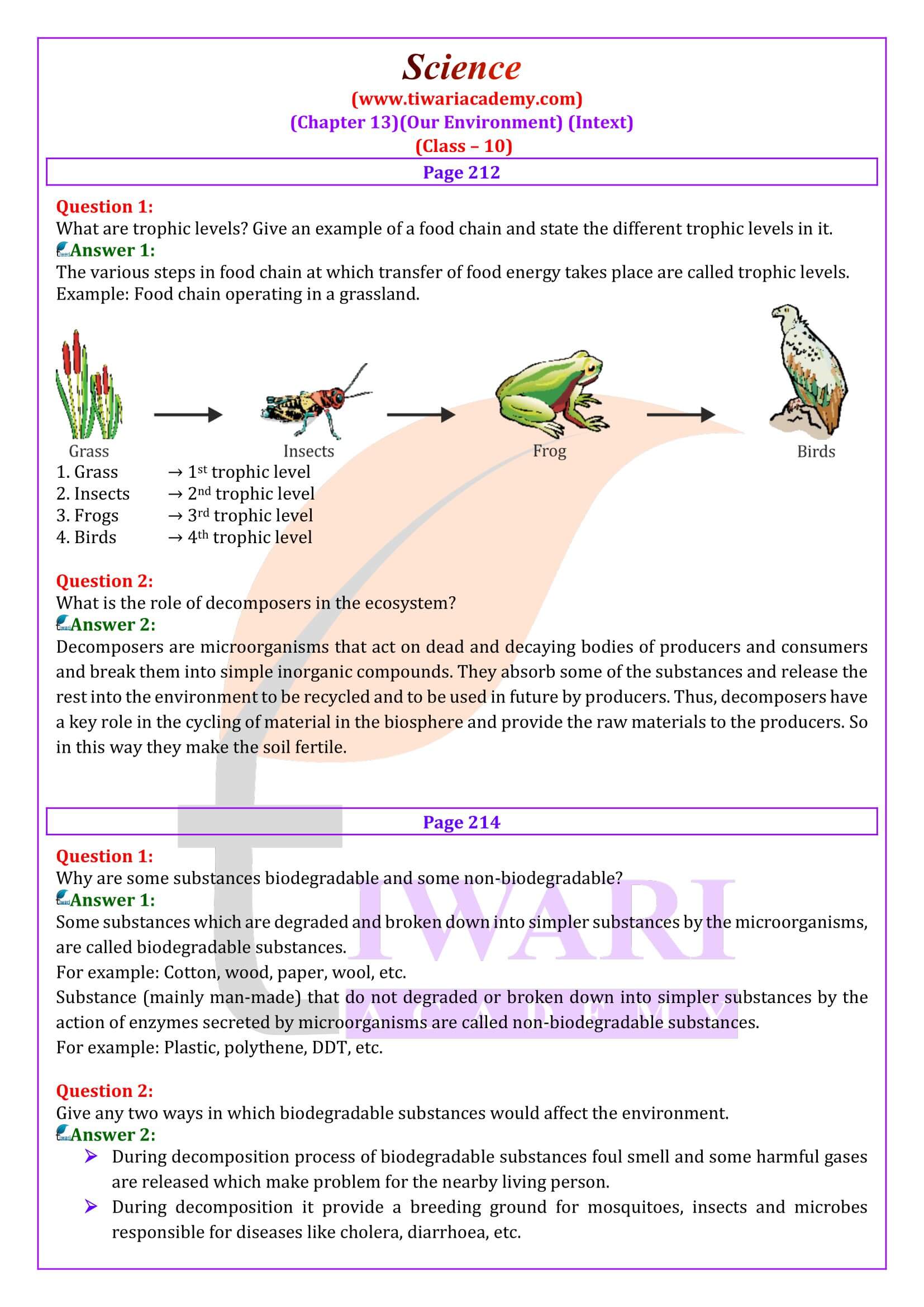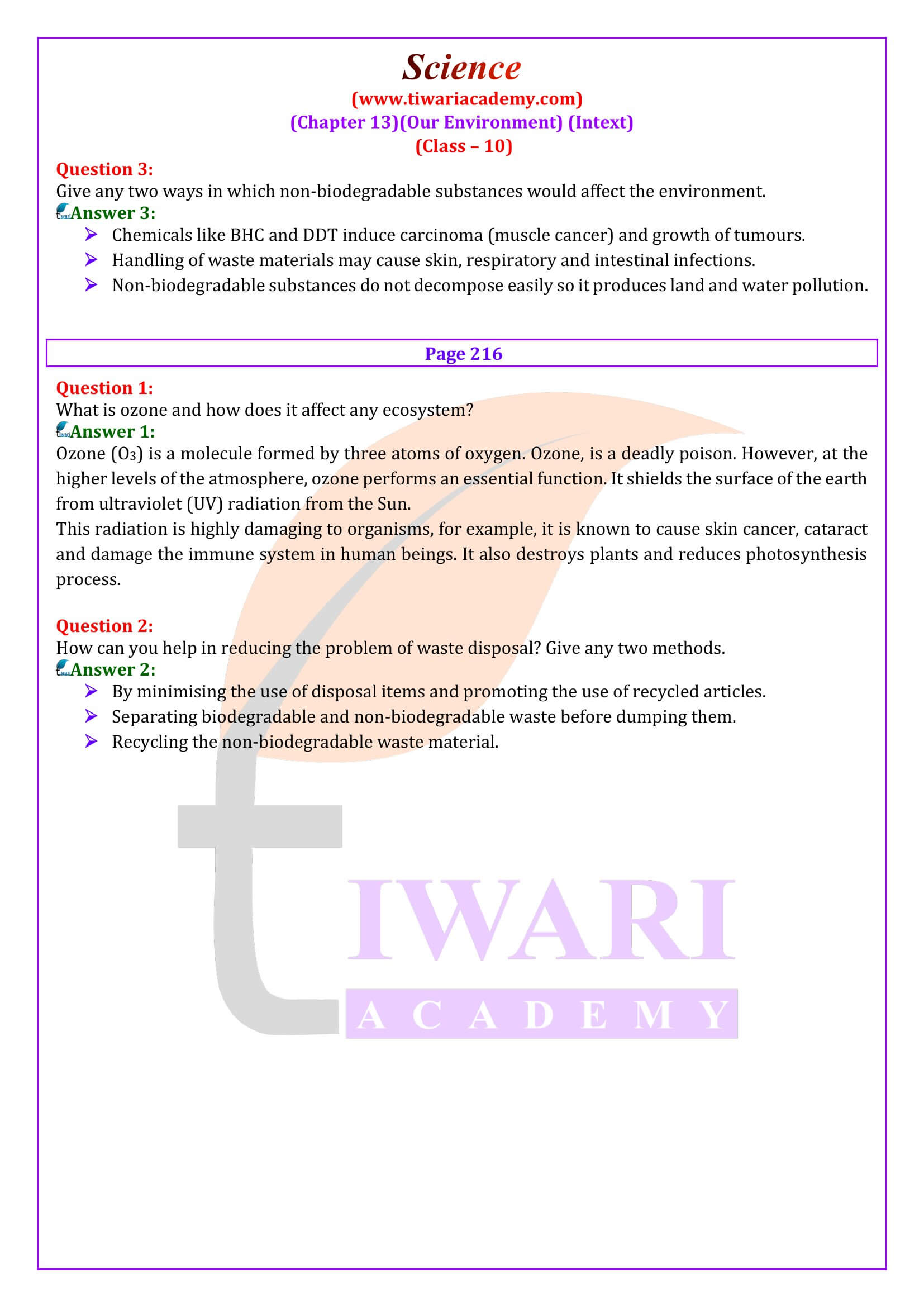NCERT Solutions for Class 10 Science Chapter 13 Our Environment in Hindi and English Medium for new CBSE session 2025-26. The question answers of chapter 13 class 10 Science is revised and updated according to textbooks published for 2025-26.
Preparation of 10th Science for Board Exams
Class 10 Science Chapter 13 Solutions
Class 10 Science Chapter 13 Exercises Solutions
Class 10 Science Chapter 13 Intext Exercises
Class 10 Science Chapter 13 MCQ
Class 10 Science Chapter 13 in Hindi Medium
Class 10 Science Book Download in PDF
Class 10 Science Chapter 13 Board Questions
Class 10 Science Chapter 13 Extra Questions
| Class: 10 | Science |
| Chapter 13: | Our Environment |
| Content: | Intext and Exercise Answers |
| Mode of content: | Text, PDF and Online Videos |
| Session: | CBSE 2025-26 |
| Medium: | English and Hindi Medium |
Class 10 Science Chapter 13 Answers in Hindi and English Medium
The topics covered in NCERT Class 10 Science Chapter 13 Our Environment is Ecosystems, an ecosystem is a community of living organisms that interact with each other and their physical environment. Ecosystems can be small, such as a pond or a tree, or they can be large, such as a forest or a desert. Food chains and webs, a food chain is a linear sequence of organisms in which each organism eats the one below it and is eaten by the one above it. A food web is a complex network of interconnected food chains.
Managing the Garbage That We Produce
Garbage is a major environmental problem. We produce too much garbage, and we don’t dispose of it properly. This can lead to pollution and health problems. Carbon and its compounds, carbon is a very important element. It is found in all living things, and it is also used to make many products, such as plastics, fuels, and medicines.
Periodic classification of elements, the periodic table of elements is a table that organizes all of the known elements in order of their atomic number. The periodic table can be used to predict the properties of elements and to understand how they react with each other. The chapter also discusses the ozone layer and how it is getting depleted. The ozone layer is a layer of gas in the upper atmosphere that protects us from harmful ultraviolet radiation from the sun. Depletion of the ozone layer can lead to increased cases of skin cancer and other health problems.
The chapter 13 of 10th science also discusses the importance of waste management. It explains the difference between biodegradable and non-biodegradable substances and provides tips on how to reduce and manage waste. Overall, NCERT Class 10 Science Chapter 13 is a comprehensive chapter that covers a wide range of topics related to the environment. It is an important chapter for students to understand in order to become more informed and responsible citizens.
NCERT Solutions for Class 10 Science Chapter 13
Class X Science chapter 13 intext questions given on Page 257 or Page 261 or Page 264 and Exercises questions answers in English and Hindi Medium updated for new session. Download NCERT Solutions Offline apps in Hindi and English Medium free for 2025-26. 10th Science Chapter 13 answers in Hindi Medium to study online free or download in PDF format.
To study NCERT Class 10 Science Chapter 13 Our Environment to get good marks in the examination, you can follow the steps given here. Read the chapter carefully and make notes. Pay attention to the key concepts and definitions. You can also use diagrams and illustrations to help you understand the concepts. This will help you to practice the concepts and to identify any areas where you need more help. Discuss the chapter with your teacher or classmates. This can help you to clarify any doubts and to gain a better understanding of the concepts. This can make learning more fun and effective.
All the NCERT Solutions are updated according to new CBSE Syllabus. UP Board students are now using NCERT Books for the academic session 2025-26. So, download UP Board Solutions for Class 10 Science Chapter 13 in Hindi Medium from here. Important Questions and previous years board exams questions with answers are also given to use free of cost. No login or registration is required to use the content on Tiwari Academy website.
Review your notes and practice problems regularly. This will help you to retain the information and to be prepared for the exam. This will help you to answer the questions more effectively. Pay attention to the important diagrams and illustrations in the chapter. These can be helpful for answering questions on the exam. Try to relate the concepts in the chapter to your everyday life. This will help you to understand the concepts better and to remember them more easily. Practice answering previous years’ exam questions. This will help you to get a feel for the types of questions that are asked and to develop a strategy for answering them.
Here are some specific tips for studying each of the main topics in class 10 science chapter 13. Ecosystems, understand the different types of ecosystems and the relationships between the different components of an ecosystem. Be able to explain the concept of food chains and food webs. Food chains and webs, be able to identify the different trophic levels in a food chain and food web.
Understand the flow of energy through a food chain and how it decreases at each trophic level. Managing the garbage that we produce, understand the different types of garbage and how they can be disposed of properly. Be able to explain the problems caused by improper waste disposal and the importance of waste recycling and composting.
Understand the different types of carbon compounds and their properties. Be able to explain how carbon compounds are used in our everyday lives and the environmental problems caused by the use of fossil fuels. Periodic classification of elements, understand the basic principles of the periodic classification of elements. Be able to identify the different types of elements and their properties. By following these tips, you can ensure that you are well-prepared for the NCERT Class 10 Science Chapter 13 board exam and that you are in a good position to get good marks.
Tiwari Academy offers a variety of resources to help students prepare well for NCERT Class 10 Chapter 13 Our Environment. These resources include NCERT Solutions. Tiwari Academy provides detailed and accurate solutions to all of the exercises in the NCERT textbook. These solutions can be helpful for students of all levels, from beginners to advanced learners. Website offers video lectures on all of the topics covered in Chapter 13. These lectures are taught by experienced and qualified teachers, and they are a great way to learn the concepts in a clear and concise manner.
Tiwari Academy provides a wide range of practice questions in Chapter 13. These questions can help students to practice the concepts and to identify any areas where they need more help. Tiwari Academy offers mock tests on Chapter 13 which help students get a feel for the types of questions that are asked in the board exam and develop a strategy for answering them. In addition to these resources, Tiwari Academy also offers a variety of other resources that can help students prepare for the board exam, such as study materials, revision tips, and exam tips.
NCERT Class 10 Chapter 13 Our Environment is a very important chapter for the board exams. It is a relatively short chapter, but it covers a wide range of topics that are essential for students to understand in order to do well in the exam. The chapter covers topics such as ecosystems, food chains and webs, garbage management, carbon and its compounds, and the periodic classification of elements.
Class 10 Science Chapter 13 Extra Questions
Mention one negative effect of our affluent life style on the environment.
Excessive use of fossil fuel, even when we have to go nearby we use car, motor cycle, etc. instead going on foot or by cycle. Fossil fuels, on burning produce oxides of carbon, nitrogen and sulphur which cause air pollution.
Why is energy flow in the biosphere unidirectional?
The sun is the only source of energy which plants trap during photosynthesis and store as food. The transfer of energy from one trophic level to the other obeys 10% law, i.e., 90% of energy is lost as heat. The energy in the form of heat goes unutilised because plants cannot use this heat energy in the synthesis of food. Thus, there is always flow of energy from the non-living component (then sun) and is released as heat. So, the energy flow in the biosphere is unidirectional.
What is an Eco-system?
Eco-system is the whole biotic community (living organisms) in a given area plus its abiotic environment (physical factors like temperature, rainfall, wind, soil and minerals) both interacting with each other and maintain a balance in nature. Eco-system can be as large as a forest, or small as a pond or lake. This functional system may be natural as forest or may be artificial (man-made), e.g., a crop field or an aquarium. Thus the Eco-system has biotic and abiotic components.
What is ozone and how it affect any Eco-system?
Ozone(O3) a molecule formed by three atoms of oxygen. It is a deadly poisonous gas. However, at the higher level of atmosphere, it performs an essential function. It shields surface of earth from ultraviolet radiation (UV) of solar radiations. This radiation is highly damaging to organisms, it is known to cause skin cancer, cataract in human beings.
10th Science Chapter 13 Answers in English & Hindi Medium
NCERT Solutions for Class 10 Science Chapter 13 Our Environment in PDF format to free download English and Hindi Medium. Download NCERT Solutions Apps for offline use. Download NCERT Solutions for class x other subjects are also in PDF format. Study online or download, use as per your requirement.
These topics are all relevant to the real world, and they are also important for students to understand in order to do well in other subjects, such as biology and chemistry. The chapter is also important because it is a good source of questions for the board exams. In recent years, the CBSE board has asked several questions from this chapter in the board exams.
Questions for Practice
Question 1:
What are two components of our environmental?
Answer 1:
(i) Biotic components: Plants and animals.
(ii) Abiotic components: Air, water, soil etc.
Question 2:
Distinguish between biodegradable and non-biodegradable substances. List two effects of each of them on our environment.
Answer 2:
Biodegradable:
(i) They can be broken into simplest form by biological processes.
(ii) They do not produce more pollution.
(iii) They remain for less time in environment.
Non-biodegradable:
(i) They cannot be broken by biological processes.
(ii) They produce more pollution.
(iii) They remain for a long time in the environment.
Effect of biodegradable substances:
(i) They release harmful gases like methane.
(ii) They release foul smell.
Effect of non-biodegradable substances:
(i) They are very harmful for the various member of the ecosystem.
(ii) They cause more pollution of air, water and soil.
Therefore, it is important for students to study NCERT Class 10 Chapter 13 thoroughly and to understand the concepts covered in the chapter. This will help them to do well in the board exams and to gain a better understanding of the environment. Here are some tips for studying NCERT Class 10 Chapter 13. Read the chapter carefully and make notes. This will help you to understand the concepts and to remember them better. This will help you to practice the concepts and to identify any areas where you need more help.
Questions from Board Papers
Question 1:
Explain the phenomenon of “biological magnification”. How does it affect organisms belonging to different trophic levels particularly the tertiary consumers?
Answer 1:
When any harmful chemical like DDT, BHC enters in a food chain the concentration of chemical increases as the trophic level is increased (i.e., next higher level). The phenomenon is called biological magnification.
These chemical, get accumulated progressively at each trophic level. It is maximum at the top (highest) trophic level. The tertiary consumers occupy the top trophic level (in most of the food chains) so there is maximum concentration of the harmful chemicals ant they are affected badly.
Important Questions on 10th Science Chapter 13
What will happen if we kill all the organisms in one trophic level?
If we kill all the organisms in one trophic level, the transfer of food energy to the next trophic level will stop. This will cause a break in the food chain resulting in ecosystem imbalance. As a result, the organisms of the higher trophic level will also die, while the individuals of the lower trophic level will exhibit enormous growth in their population. Both the conditions will result in ecological upset.
Will the impact of removing all the organisms in a trophic level be different for different trophic levels? Can the organisms of any trophic level be removed without causing any damage to the ecosystem?
Yes, the impact of removing all organisms in a trophic level will be different for different trophic levels. If all the producers are killed, it will cause death or migration of the primary consumers in the ecosystem. In the absence of producers, subsequent level of consumers will also be affected. But if primary consumers are removed, organisms of higher trophic level will die, while those of lower level (producers) show exponential growth much beyond the carrying capacity of the environment. Removal of the organisms in a trophic level will upset the whole ecosystem as all categories of organisms are linked through food chain. The survival of organisms of one trophic level depends on the existence of the members of other trophic level.
What is biological magnification? Will the levels of this magnification be different at different levels of the ecosystem?
Progressive increase in the concentration of non-biodegradable substances in a food chain is called biological magnification. The level of these harmful substances will go on increasing from one trophic level to the next. When certain harmful substances enter the food chain at the level of primary producers,-they get concentrated many times at each subsequent trophic level.
What are the problems caused by the non-biodegradable wastes that we generate?
Non-biodegradable wastes cannot be broken-down into simpler substances. Their volume keeps on increasing creating the problem of their safe disposal. Some of the non-biodegradable wastes like heavy metals and pesticides enter into the food chain and increases in the upper trophic levels. Non-biodegradable wastes reduce the soil fertility by changing the natural pH balance.
If all the waste we generate is biodegradable, will this have no impact on the environment?
Biodegradable wastes are decomposed by microorganisms into simpler substances themselves and provide raw materials for producers, but they also have adverse effects on the environment: Slow decomposition of biodegradable waste will result in the release of foul smell and harmful gases. When inhaled by human beings, they may cause irritation, nausea, giddiness, etc. Decomposing waste provides breeding ground for some harmful organisms. Abundance of harmful microorganisms may cause diseases in animals, plants and human beings. Increase in the number of microorganisms in aquatic medium will- cause oxygen deficiency in waterbodies.
Why is damage to the ozone layer a cause for concern? What steps are being taken to limit this damage?
Ozone layer is a protective shield around the earth. It prevents harmful ultraviolet radiation of the sun from reaching the earth. Air pollutants, like chlorofluorocarbons (CFCs), are causing depletion of ozone layer. This is allowing greater amount of UV radiation to reach the earth. UV radiation can upset the ecosystem by affecting photosynthesis in plants, destroying planktons and decomposers. In human beings, UV radiation may cause skin cancer, cataract of eyes and damage to immune system. Several developed as well as developing nations of the world have agreed to sign and obey the directions of TINEP (United Nations Environment Programme) to freeze the production of CFCs or to 1imit their production to some extent.
Why are some substances biodegradable and some non-biodegradable?
Some substances which are degraded and broken down into simpler substances by the microorganisms, are called biodegradable substances. For example: Cotton, wood, paper, wool, etc. Substance (mainly man-made) that do not degraded or broken down into simpler substances by the action of enzymes secreted by microorganisms are called non-biodegradable substances. For example: Plastic, polythene, DDT, etc.
Give any two ways in which biodegradable substances would affect the environment.
During decomposition process of biodegradable substances foul smell and some harmful gases are released which make problem for the nearby living person. During decomposition it provide a breeding ground for mosquitoes, insects and microbes responsible for diseases like cholera, diarrhoea, etc.
Give any two ways in which non-biodegradable substances would affect the environment.
Chemicals like BHC and DDT induce carcinoma (muscle cancer) and growth of tumours. Handling of waste materials may cause skin, respiratory and intestinal infections. Non-biodegradable substances do not decompose easily so it produces land and water pollution.
What is the role of decomposers in the ecosystem?
Decomposers are microorganisms that act on dead and decaying bodies of producers and consumers and break them into simple inorganic compounds. They absorb some of the substances and release the rest into the environment to be recycled and to be used in future by producers. Thus, decomposers have a key role in the cycling of material in the biosphere and provide the raw materials to the producers. So in this way they make the soil fertile.
How can you help in reducing the problem of waste disposal? Give any two methods.
By minimising the use of disposal items and promoting the use of recycled articles. Separating biodegradable and non-biodegradable waste before dumping them. Recycling the non-biodegradable waste material.
What is ozone and how does it affect any ecosystem?
Ozone (O3) is a molecule formed by three atoms of oxygen. Ozone, is a deadly poison. However, at the higher levels of the atmosphere, ozone performs an essential function. It shields the surface of the earth from ultraviolet (UV) radiation from the Sun. This radiation is highly damaging to organisms, for example, it is known to cause skin cancer, cataract and damage the immune system in human beings. It also destroys plants and reduces photosynthesis process.
Question 2:
The flow of energy in food chain is unidirectional. Why?
Answer 2:
The flow of energy in a food chain follows 10% law. The energy used or lost in environment as heat, cannot enter at any trophic level in the food chain. Only solar energy can enters in the food chain at producer level and ultimately get lost as heat.
Discuss the chapter with your teacher or classmates. This can help you to clarify any doubts and to gain a better understanding of the concepts. This can make learning more fun and effective. By following these tips, you can ensure that you are well-prepared for the NCERT Class 10 Chapter 13 board exam.
How is chapter 13 our environment of class 10th Science?
Chapter 13 our environment of class 10th Science is a very easy and interesting chapter. In this chapter, students will study all about the environment. Also, students will be studying how various components in the environment interact with each other and how people impact the environment. Topics that students will study in chapter 13 are:
- Eco-System — what are its components?
- Food Chains and Webs
- How Do Our Activities Affect The Environment?
- Ozone Layer and how it is Getting Depleted
5. Managing the Garbage we produce
Is chapter 13 of grade 10th Science short and take less time to complete?
Yes, chapter 13 of grade 10th Science is short compared to other chapters of grade 10th Science. Chapter 13 has 16 questions. Students require 8-10 days to finish chapter 13 of class 10th Science if they give 1 hour per day to this chapter. This time is an approximate time and can vary because every student has a different working speed, efficiency, capability, etc.
In which field chapter 13 of standard 10th NCERT Science belongs to?
Chapter 13 of grade 10th Science belongs to biology. Chapter 13 is not a physics chapter and not a chemistry chapter. Also, this chapter will come in the term 2 examinations. Chapter 15 is the easiest.
Which questions of chapter 13, class 10th Science, have a chance to come in exams?
Chapter 13 has 16 questions. 7 questions are in between chapter 13 and 9 are in the back exercise of chapter 13. Questions 2, 3 (page number 257), questions 1, 2 (page number 261), questions 1, 2 (page number 264), and questions 4, 6, 7, 8, 9 of back exercise of chapter 13 have more chance than other questions of this chapter to come in term 2 exams.







